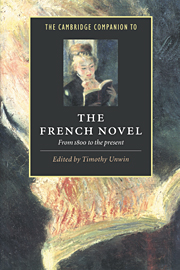Book contents
- Frontmatter
- 1 On the novel and the writing of literary history
- 2 Novels of testimony and the 'invention' of the modern French novel
- 3 Reality and its representation in the nineteenth-century novel
- 4 Women and fiction in the nineteenth century
- 5 Popular fiction in the nineteenth century
- 6 Decadence and the fin-de-siècle novel
- 7 The Proustian revolution
- 8 Formal experiment and innovation
- 9 Existentialism, engagement, ideology
- 10 War and the Holocaust
- 11 From serious to popular fiction
- 12 The colonial and postcolonial Francophone novel
- 13 The French-Canadian novel
- 14 Gender and sexual identity in the modern French novel
- 15 Postmodern Frenchfiction
- General bibliography
- Index
5 - Popular fiction in the nineteenth century
Published online by Cambridge University Press: 28 May 2006
- Frontmatter
- 1 On the novel and the writing of literary history
- 2 Novels of testimony and the 'invention' of the modern French novel
- 3 Reality and its representation in the nineteenth-century novel
- 4 Women and fiction in the nineteenth century
- 5 Popular fiction in the nineteenth century
- 6 Decadence and the fin-de-siècle novel
- 7 The Proustian revolution
- 8 Formal experiment and innovation
- 9 Existentialism, engagement, ideology
- 10 War and the Holocaust
- 11 From serious to popular fiction
- 12 The colonial and postcolonial Francophone novel
- 13 The French-Canadian novel
- 14 Gender and sexual identity in the modern French novel
- 15 Postmodern Frenchfiction
- General bibliography
- Index
Summary
'Popular' literature is valued because it gives direct access to the collective heartbeat. Cultural historians, formalists (who seek out its structures) and psycho-sociologists look to it to reveal the permanence of the communal experience. But literature which is popular has properties which, though definable, are too elusive to take any single shape. Cinderella, Robin Hood and Robinson Crusoe are all popular in different ways. The first is a folk myth sired by a Darwinian process of survival. The second is a folk hero shaped by anonymous hands out of a real life. The third is a character in a book written by an individual. Nineteenth-century France was familiar with all three types. 'Bonhomme Misère' - Poverty - survived in the cheap tracts hawked by pedlars known as littérature de colportage; Napoleon was turned into a new Charlemagne; and d'Artagnan was a legend in his creator's lifetime. But after 1800, popular literature began to acquire a new common denominator: it was transmitted by the printed page. No longer expressed by word of myth, it resumed its career in created fictions.
- Type
- Chapter
- Information
- The Cambridge Companion to the French NovelFrom 1800 to the Present, pp. 73 - 92Publisher: Cambridge University PressPrint publication year: 1997



